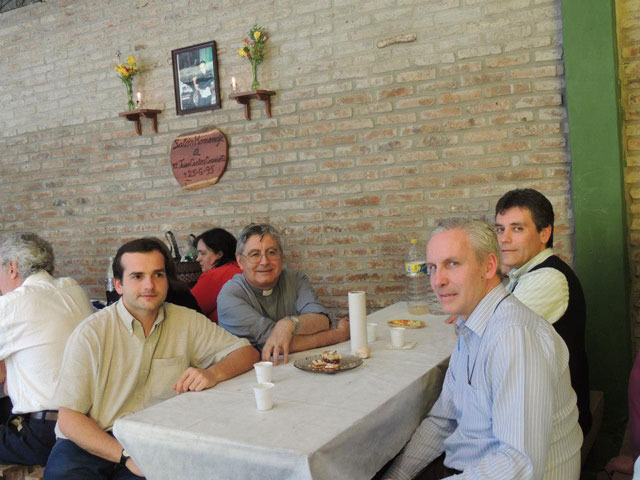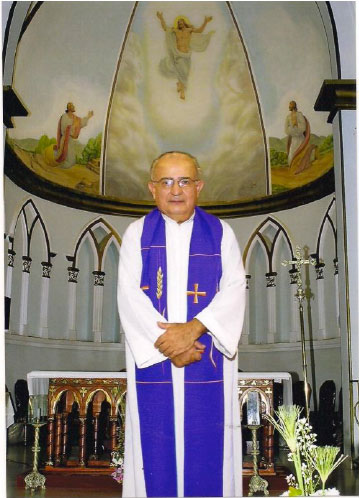Family News - 2012 September 14th
Contents
- A word from the Superior general
- Saint Michael Garicoïts wrote...
- Towards the 150th anniversary
- Lay Spirituality
- 5 minutes with the Ciudad del Este community - Paraguay
- In Memoriam : Fr Rogelio Léon Ramírez Cardozo
- A History of the General Chapters of the Congregation of the Sacred Heart of Jesus of Betharram (8)
| formato PDF |
A word of the Superior general
BETHARRAMITE PRAYER LIFE
In the preceding chapters of the Rule of Life it was obvious that spiritual life is the very life of our Baptism and consecration guided by the Holy Spirit. A life of communion with the living person of Jesus Christ with whom we are configured, joyfully offering him our lives to love him in all things in the service of the Father and the brethren.This life in the Holy Spirit is not only part of our prayer but is also typical of all dimensions of our life, of our whole being, our consecrated life, community and mission, our activities and relations in our different commitments for from the day of our Baptism we are associated as children with the offering of Jesus to his Father, seeking thus to be pleasing to him in all things.
In order to maintain such a lively and rich experience it is necessary to pray as Article 1 of the Rule of Life recommends. A life of prayer must have as its model Christ in prayer (Rule of Life 70); it must cultivate the three fundamental attitudes: union with the Father, seeking his presence, listening to his Word and accepting his love (Rule of Life 71). Real prayer leads us to discernment, to a taste for the Word of God, to gratitude for the countless graces by which our Heavenly Father manifests his love in my life.
A personal prayer aiming to be a filial prayer.
Knowing that we are children in the Son helps us to lead lives in a constant attitude of adoration, of thanksgiving, of offering, of seeking the will of the Father (Rule of Life 74). Adoration is recognising the primacy of God and our radical dependence on him in all things; thanksgiving means thanking God for the marvels which he has accomplished and continues to accomplish in the History of mankind, in our Congregation and in our own existence. The offering of ones self means abandoning into the hands of God what we are and what we do so that united to the offering of Jesus Christ on the Cross and in the Eucharist we enter into that plenitude which far exceeds our fragile nature.
Seeking the Will of God helps us to recognise, in all the events and meetings we may have in the course of our ministry, what is the will of God for us and reply with enthusiasm like Jesus: Here I am, Father, I come to do your Will. We seek Gods will through the lectio divina and the daily examen. In the case of the first for which we take time every morning, the Word of God throws a light on our state of life and opens up new avenues to salvation. It is important to be faithful to these means every day.
In the examen we pay attention to events, situations, and personal encounters so as to discover in all situations the extent to which the presence of the God of Love challenges us, tries us, purifies us and gives us the opportunity of growing in humanity, in fraternity towards those with whom we are living.
Our annual retreat and spiritual accompaniment are further important means to help us to steer clear of illusions and to reply to the calls of faith which can easily suffer from routine and the demands sometimes excessive of our apostolic work. Finally our whole life is a prayer whether it is in duty well done, how we treat those we meet with respect, whether it is in relaxation, silence or solitude, since we are responsible for the mission entrusted to us and community services, we are doing Gods Will and we are of service to the men with whom we are living. When we live like this or when we are in prayer our entire religious life becomes a sign which announces Jesus Christ. (Rule of Life 13).
Community prayer which is fraternal.
The Eucharist is the source and summit of our Christian life. This is made possible by our life in community by which we become brothers. May the Holy Spirit unite all those who receive the Body and Blood of Christ (Eucharistic Prayer 2). The Eucharist continues throughout our day with the celebration of the Hours, the visit to the Blessed Sacrament and in the times of adoration in community.
In the course of the narratio fidei we share what the Lord is performing in us as we bear witness to his love in the midst of our brothers and we are revived in faithfulness to our vocation. We also share the wonders which God is performing in each individual, in communities, as well as all the wonders of which we are witness thanks to our vocation and mission.
An apostolic prayer aware of the needs of others.
Before we start talking to humanity about God it would be a good idea to talk to God about humanity! Praying before or after our missionary apostolate gives it its true dimension thanks to the relationship which is developed with him who is the fount of our lives, the encounter with Jesus Christ who draws all men to himself.
Prayer maintains in us an evangelical vision on every situation, events and all human reality so as to discover the signs and challenges which the Lord is showing us through the signs of the times.
Through prayer we can discover so many signs of the love and tenderness of God in mens lives and we can offer them to the Father with the offering of Jesus on the Cross and in the daily Eucharist.
Congregation celebrations.
These are annual occasions to thank the Lord for the gift of the charism accorded to St Michael Garicoits, a gift through which we offer what we do and what we are. But especially for all the wonders which the Sacred Heart continues to realise in our brothers, our communities and in the midst of those to whom we have been sent so that Jesus Christ is known, loved and served.
Gaspar Fernández Pérez, SCJ

 Saint Michael Garicoïts wrote...
Saint Michael Garicoïts wrote...
The God doesnt treat us as though we were slaves making his Will known to us in a peremptory manner. He treats us like his beloved children, even letting us know his advice and his plans; and to each of us, he says If you love me keep my commandments. Who could be so hard hearted as not to be won over? Hearing everything with a great and joyful heart, as he reflects on who it is who is thus speaking to him in such terms and with such extraordinary and indescribable gentleness? Those who love God will be filled with his law: cura disciplinae, dilectio est; et dilectio custodia legum istius est (the zeal for instruction is love, and love is the keeping of her laws [Wis 6:18]). All who love God prove it by keeping his laws perfectly. This is how genuine love is proved.
(M 374)
Towards the 150th anniversary...
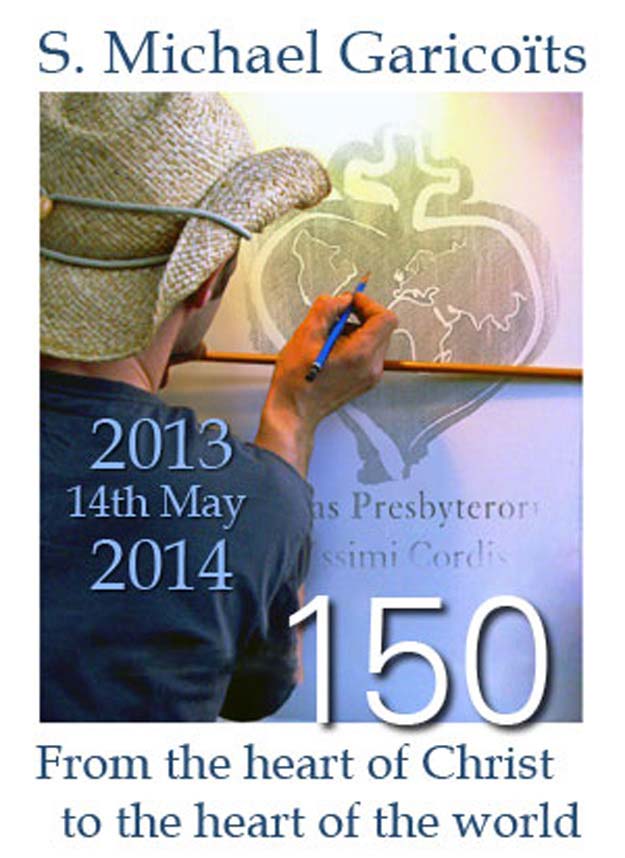
OUR ITINERARY TOWARDS THE 150th ANNIVERSARY IS GATHERING SPEED
Starting from this September issue we will publish bimonthly some fiches prepared by Frs Gaston Hialé and Philippe Hourcade in order to help our preparation for the celebration of the 150th centenary of the death of our Founder.
Four fiches for four community meetings (of an average duration of three hours): you will find turnkey patterns for your personal reflection and for the community meeting.
The authors: It seemed right to us to enhance each of these fiches with the mysteries of the Rosary so as to stress the deep link joining Me Voici of Christ to the Behold the handmaid of the Lord of his Mother:
In the Joyful mysteries: the Annunciation;
In the Luminous mysteries: the Proclamation of the Kingdom of God; (it has seemed to us that here the laity can be with us in our wish to be witnesses and helpers in making this proclamation);
In the sorrowful mysteries: Jesus carries his Cross: (here we could pray with the Stations of the Cross since the Betharram Calvary will soon be celebrating its 4th centenary);
In the Glorious mysteries: the Ascension of Jesus since this is the day on which St Michael died.
A deep dynamism
The Manifesto is our origin; this year it can become a means of reviewing in community the state of our fraternal and apostolic life. Consequently we are suggesting dividing it into four sections which could be as many themes for the 4 meetings.
The first paragraph for the first meeting; The second for the next one, etc.
There will be themes for the suggested review which can be arranged for each of the communities.
A common approach
It seemed important to us to suggest a common approach for the 4 meetings with sufficient facilitation so that they can be a type of recollection. Evidently, each community is free for its own organisation. In the plan suggested by our superiors, it seems ideal, never the less, to reserve an important place for sharing around the narratio fidei whether it is a scripture text or the Founders text.
a- moment of prayer to begin with: a psalm, the Word of God, 10 mn silence followed by spontaneous shared prayer.
b- sharing of the Founders text, presented as a narratio fidei.
c- review of our religious life based on part of the Manifesto: possibility of switching b and c.
d- Community prayer: We suggest that for meetings 1, 2, and 4 to use the mystery of the Rosary for prayer; for meeting 3 we suggest praying with the Betharram Stations of the Cross prepared by Fr Hialé.
FICHE 1
The Mystery of the Annunciation
Introduction to the meeting: praying together
Suggestions and plan:
Pray together psalm 39 from Me Voici.
Read these extracts from Luke: 1, 28 and 1, 46-48.
10 minutes silence.
Sharing spontaneous prayer of intercession, praise, thanksgiving.
Sharing a text on our charism
Under the form of a narratio fidei.
This is a passage from Spiritual Doctrine pages 134-5.
Introduction: Saint Michael, writing to a religious friend of the Daughters of the Cross, shares with her what he has experienced from his contemplation of the face of the Father entering into Marys experience .
Our sharing can be divided into two parts: according to St Michael, what face of the Father does Mary experience? As for ourselves, what face of the Father does our life experience make us discover?
Review of our religious life in the light of the Manifesto
We suggest keeping to the first paragraph.
It has so pleased God to be loved, and, while we were his enemies, he loved us so much that he sent us his beloved Son; he gave him to us to be the magnet which is destined to draw us to divine love, to be the model showing us the rules for love, and the means to reach divine love: the Son of God became Man.
From the very beginning we are invited to adopt an attitude of welcome and contemplation, to see only the relationship he wishes to have with us before our relationship with him. It is all a question of being rooted in the priority of the movement of love of the Father in Jesus. We can also fix our attention on the three words which show us the figure of Christ: magnet, model and means and see what echo they find in us, what they suggest to us for and in our spiritual experience (in preparation for this meeting, it is possible to read the words of Pope Benedict XVI who, in his first encyclical letter, invited us to change our vision of God... much the same way as Saint Michael does. See p. 6)
Community prayer with the Rosary
We can meditate on the mystery dealing with the Annunciation. With and through Mary contemplate the Good News of the loving visage of the Father inviting us to the same attitude of abandonment and freedom of the Spirit in our lives. The fruit of this mystery could be expressed thus:
To receive a heart open to a Love which is fulfilling and is available, joyful and ready to reply Here I am no delaying, no reservations, no looking back!
Text of Pope Benedict XVI in his encyclical letter Deus Caritas Est, Numbers 9 and 10, in response to the perspective of a divine love seeking and longing for a human love.
The newness of biblical faith
9. First, the world of the Bible presents us with a new image of God. In surrounding cultures, the image of God and of the gods ultimately remained unclear and contradictory. In the development of biblical faith, however, the content of the prayer fundamental to Israel, the Shema, became increasingly clear and unequivocal: Hear, O Israel, the Lord, our God is one Lord (Dt 6,4), there is only one God, the Creator of heaven and earth, who is thus the God of all... Consequently, his creation is dear to him, for it was willed by him and made by him. The second and important element now emerges: this God loves man... the one God in whom Israel believes loves with a personal love. His love, moreover, is an elective love: among all the nations he chooses Israel and loves her but he does so precisely with a view to healing the whole human race. God loves, and his love may certainly be called eros, yet it is also totally agape.
The history of the love-relationship between God and Israel consists in the fact that man, through a life of fidelity to the one God, comes to experience himself as loved by God, and discovers joy in truth and in righteousness a joy in God which becomes his essential happiness
10. We have seen that Gods eros for man is also totally agape. This is not only because it is bestowed in a completely gratuitous manner, but also because it is love which forgives... It is so great that it turns God against himself, his love against his justice. Here Christians can see a dim prefigurement of the mystery of the Cross: so great is Gods love for man that by becoming man he follows him even into death, and so reconciles justice and love.
TOWARDS THE 150th ANNIVERSARY ...
LET US PRAY TOGETHER
Starting from October 1st, the General Council will send to all the Religious, via the Regional Superiors and Regional Vicars (by email), a monthly prayer which will help us to live the Year of Saint Michael. This common prayer will make us voices of one chorus and feel part of one body irrespective of which country we live in. The prayer will also be published on the website page dedicated to the 150th anniversary.
Lay Spirituality
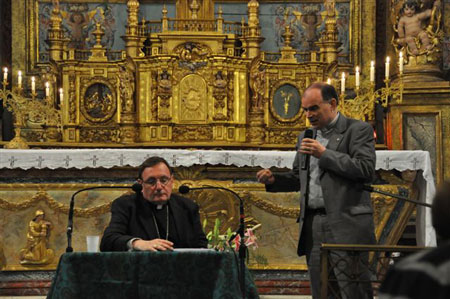
BE OUR QUEEN!
On 28th July 2012 a very solemn celebration of the 100th anniversary of the crowning of Our Lady and the Infant Jesus was held in Betharram. Around Mons Jean Laffitte (Secretary of the Pontifical Council for the Family and alumnus of Betharram) a great number of Religious and Laity were a living crown for Our Lady of Betharram. She keeps stretching out the beautiful branch for all those who pray to her
What follows is an excerpt of the account written by a betharramite layman, Mr Jean Leid.
Lord, open my lips! The day which is breaking with praise, promises to be beautiful and full of meaning. Just 100 years ago on 28th July 1912 the beautiful white statue of Our Lady of Betharram holding her infant received the two crowns of gold and precious stones offered by Pope St Pius X. This crowning ceremony, which was the fourth to be celebrated in the region after that of Buglose, Sarrance and Lourdes, showed the importance at the time of rousing the faithful for the cult of the Virgin Mary. A century later, it was even more important to honour and cherish the Mother of Our Lord, Queen of the Universe according to the very words of Vatican II.
The cortege is followed by a delegation of priests among whom are diocesan clergy but especially the Betharram Priests from the different communities. The crowd advanced on both sides of the mobile loud speakers; the parishioners from Lestelle and the surrounding countryside are there; it would be unthinkable to miss such a lovely ceremony so near to home! The Friends of Betharram closed ranks: the Me Voici Fraternity, Au Coeur du Monde, the faithful from the Holy Ghost Masses at St Michaels House, and individuals of all kinds. Some had found a forgotten or neglected pathway, others were discovering a new pathway; later during the day this would be an opportunity for recalling the past but above all for talking about the future. The cortege was completed with the male and female religious of the region.
Before the beautiful 17th century facade, austere in grey marble but majestic with its onion shaped roofs, the travelling statue is turned towards the faithful, a silver branch placed at its feet. Mgr Laffitte blessed this branch which will be brought back to Italy along with the little olive branches which had travelled the other way round. Later on they will be presented to the faithful to be a perpetual reminder of such a day linking the faithful together and with their Mother.
And now comes the solemn entry into the sanctuary.
In his welcoming speech, Fr Jean-Luc Morin, Regional Superior, spoke of a family gathering, of the tenderness of a Mother, then he paid homage to the Fathers of Betharram many of whom were there present. More than crowns on the statue, these religious make up the most beautiful of crowns in the choir. These Sacred Heart religious are the crowning joy of Our Lady for so many years of devotion and fidelity to Me Voici which they pronounced one day. Next in the silence of the assembly the names of the dozen or so jubilarians there present were read out - the oldest of them was Father Joseph Canton, who was born two years before the crowning of the statue in 1912, and now bearing on his frail shoulders the weight of 85 years of religious profession!
Mgr Jean Laffitte, Secretary of the Pontifical Council for the Family, who had arrived from Rome for this purpose, now presides the celebration. On his right is Fr Enrico Frigerio, Vicar General representing the Superior General. In his homily, Mgr Laffitte reminded his audience that he had been a pupil of Notre Dame College. He explained the liturgical meaning of the crowning of the statue, and with St Johns Gospel which had just been read showed the close links between Jesus and his Mother, she who at the foot of the Cross became the Mother of all believers: Mother of the Church and Mother of each one of us. Such a close relationship shows why Pope Pius X wanted to crown both the Mother and Child. He also told us that his personal attachment to Betharram made him include the lovely branch in his bishops coat of arms.
At last time had come for refreshments! The community had sent out invitations far and wide for a friendly meal in the Gymnasium. After Grace had been said the great hall came to life; the organisers of the event went from table to table, finding proof among the guests that the miracle of the communion of Saints was still to be found in Betharram.
The sky had begun to clear when the 200 guests came out to assist at Vespers, presided by Mgr Laffitte, in the main Chapel. Today, the Magnificat, summit of evening prayer, took on the fullness of its meaning. In front of the main altar a small table has been installed equipped with two microphones. After a talk came a question and answer session; Mgr Laffitte described briefly the Institution of which he is Secretary. He stressed its world-wide appeal, mentioned the threats which law-makers are placing on the family, and wondered at the relative apathy of Christians in the West in the face of certain drifts. The exchanges which followed widened the debate according as the different manner of tackling the problems showed the seriousness of the challenges.
So ended an unforgettable day! Its not every day that there is an opportunity of celebrating a centenary! Those who spent the 28th July at Betharram were very lucky indeed: lucky to be in a place oozing with History, but also with histories both personal and collective; lucky to have seen Our Lady crowned with real crowns offering her lovely branch as a sign that she is ever present for anyone who humbly implores her; lucky to have rubbed shoulders with those Religious of all ages, borne on their way by the same vocation and through them to have received something of Jesus and his Mother.
Jean Leid
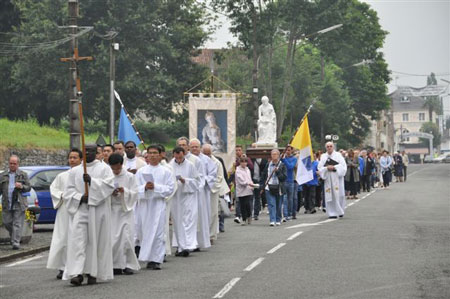
5 minutes with con...
... the community at Ciudad del Este - Paraguay
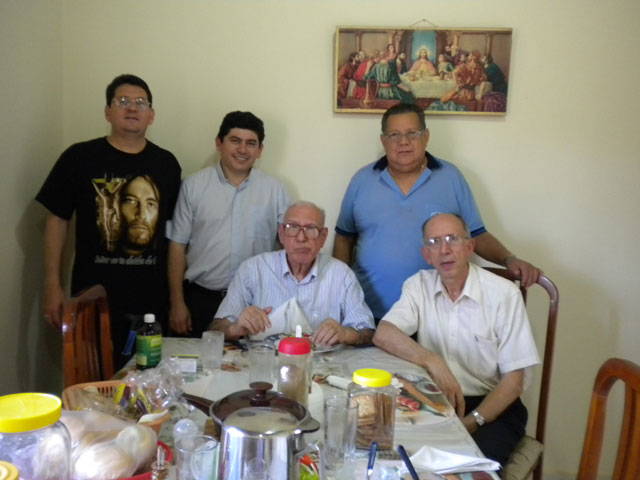
Ciudad del Este is a densely populated town. It was founded in 1957 and had a staggering growth in population. The Betharramite Community has been there since 1997, when the Bishop entrusted them with the task of human and Christian education of the youth (a College was opened) and with the pastoral care of a vast pastoral area. This is what the members of the community wrote about themselves
Nef : How long has there been a community in Ciudad del Este? Why have we settled there?
- The first Betharramite religious arrived in Ciudad President Stroessner in July 1977. It has since come to be known as Ciudad del Este. The first team was made up of Fr Wilfrido Romero and Tobia Sosio; Brother Frederico Penayo joined them some time later. At that time the hydro-electric station was under construction at Itaipu; 40.000 workmen (half of them from Paraguay) gave a new lease of life to the town which became a huge building site. The Bishop, Mgr Augustin Van Aaken had asked the Congregation to open a college and to accept responsibility for the vast pastoral zone around the town where new sectors were growing like mushrooms. There was also the wish and request of a lot of the engineers and technicians in Itaipu, past pupils of St Josephs College in Asuncion, who wanted to send their children to a college with the same tradition. The Congregation could rely on a 10 hectare piece of land only 4 km from the frontier ideal for the new institution.
What was the social aspect of this location where the community was sent?
-Before that there had already been Itaipu, the largest hydro-electric barrage in the world; then being close to the frontier with Brazil and Argentina there were the waterfalls of Yguazu which were going to change the region quickly to become a huge touristic and industrial centre. Then this encouraged massive immigration so much so that the town increased to 180.000 inhabitants in the space of two years. The voice of the Gospel had to be present through education and pastoral care in a place where many were seeking to make a quick buck. The deeply religious sentiments of the people from Paraguay helped in the construction of a church in each sector.
How does the community take part in the projects of the diocesan Church?
-When I look at the history of the period, I would say that at the beginning, especially during the time of Mgr Augustin, there was real pastoral done together. There was yet no diocesan clergy and the many religious communities both male and female in the diocese took an active part in the diocesan initiatives. For several years, the Betharramites were entrusted with directing the catechetic for the schools and families. More recently and with the present bishop there is greater scattering; there is little contact between the diocesan clergy and the religious; something else which is noticeable is the lack of continuity with the dynamics of earlier days at diocesan level. However, these difficulties dont discourage us! Fr Fulgencio Ferreira is the actual parish priest; as well as that he is diocesan assistant for the Catechetical Formation at diocesan level. On the other hand, at parish level, there is good co-operation and constant growth in every sense of the word.
What is the parish community like which the religious have succeeded in building?
- Of the original parish five new ones have been created! The actual Sacred Heart Parish has been formed with 8 communities (known as Chapels) plus the Parish Centre. That represents about 25.000 souls. What is typical of the sector is the participation of the laity in the different parish sectors (catechism, youth, health, family, liturgy, vocations) as well as in the different movements for the Laity, such as the Legion of Mary, the Franciscans, the Charismatic, and Christian Families, retreats, the youth and the Betharramite children. There is a good turnout for Sunday Mass and weekday masses, both in the parish and in the chapels. There is plenty of work for the three priests and Brother Sixto. As for Brother Alfredo, he accompanies us by his prayer and the example of his life.
What has priority in the department of education?
-St Josephs College is top of its class with nearly 950 pupils, housed in huge buildings which are well maintained. The headship and administration are in the hands of the laity; as for us religious, we try to give it a sort of Christian atmosphere, linked to Betharramite spirituality. This we do through religious education, retreats for the pupils, the staff and the parents. This year we have stressed the importance of work with the family. Whether its the pupils or the parents all are ready to discuss matters of faith. The noisy and materialist environment drives people to seek places for reflexion and superior values. This is why the College still organises a camp for evangelisation. Paraguay is a country where 70% of the population is under 30 years of age; with such a pourcentage of young people there is great need of evangelical values.
How does the community cope with the two missions the parish and the College?
- Because the community is the meeting point of the two realities. Since we decided to live in community in the parochial house, it has helped us in many ways. The College takes part in some parish activities (for example the patron saints day, or the beginning of the school year) The College also lends rooms to the parish for Sunday catechism or other activities organised by parish groups. The College Chapel is actually one of the 8 communities which constitute the parish and sharing the same organisation.
Are there any special occasions which the community cant avoid if you dont want to be scattered?
- That is certainly a great danger! We try to be faithful to our times of prayer together; now and again we have a day off to relax in community; we also have training sessions (this year it is on the Rule of Life); then we conclude with concelebrated Mass. These are moments which are a real help. We take part also in meetings with the other Betharramite communities and in the initiatives proposed by the Vicariate.
The General Chapter reminded us that vocational animation is the responsibility of each religious. We are not to be afraid of the young for they encourage us in a constant conversion; so, our witness can always be more coherent and we can have a positive outlook on our future. What does the community offer as a vocational appeal to the young? How?
-Our parish has always yielded a rich harvest of vocations, whether religious or diocesan vocations, male or female. Not so long ago, together with Brother Sixto we have constructed a plan for vocations to be proposed for days of reflexion on the theme of vocations allowing accompaniment afterwards. Its one way of casting the nets. The Community must always remain open to the different groups of young people... witness and prayer... we are fully aware that total commitment is something which the youngsters of today look at with great difficulty.
Fr Rogelio León Ramírez Cardozo
Ybycui, 16 September 1936 - Asunción, 9 August 2012Very soon his qualities as a navigator and a fisherman became evident. He used to tell how with his brother he built a sort of big dustbin (which must have looked like a fishing boat) which they would use during the rainy season to go fishing and sailing together on the river which skirted the town.
That was his way of showing his creative powers and his ability to face great challenges. These qualities, lived with the Lord, were useful for him later on in life to become a fisher of men full of conviction and apostolic zeal.
From his early youth he felt the Lords call to become a fisher of men as a priest. He was referred to St Josephs College in Ascension where the Apostolicat was situated, there to pursue his studies with the other Seminarians. Having finished his Secondary Education he went to Buenos Aires (1958) to the Notre Dame de Betharram seminary at Adrogue; here he made his novitiate, did his Philosophy and Theology culminating in his ordination in December 1964.
Father Rogelio was able to win the hearts of all those lucky enough to know him. From the days of his novitiate, making use of his knowledge, his skills, his creativity and his natural gifts he succeeded in solving all the problems linked to life in community as well as the maintenance of the Betharram Seminary. With his guitar, a flute and even a harmonium which he had built himself (he even taught his fellow religious how to play) he was never bored during his free afternoons. Optimism, genuine enthusiasm together with his love of life, shone out of him and impressed his fellow religious. As a newly ordained priest he taught at the Apostolicat in Asuncion. It was from here that he set out on his many trips on his motor bike into the interior of the country (Caazapa, San Juan, Ybycui, Encarnacion etc). He was involved in vocational ministry, inviting the young that he would meet to consecrate themselves in the religious life and the ministry. At the request of his superiors he moved to San Jose College in Buenos Aires as administrator for a short time. On his return to Paraguay, he was named director of the Apostolic College San Jose (1979 1984); from there he moved to San Jose College at Ciudad del Este (1985 1990)
During the time he was superior of the Vice-Province Notre Dame dAsuncion (1991 1998) he accompanied every one of the religious of the Congregation. He also shared his deep spiritual experience as a Betharramite with the seminarians, priests, religious and married couples. He inspired so much trust! He could be Father, Brother, spiritual director, councillor to the married, pastor, companion, friend generously offering a helping hand all the time. There is one thing for sure that whoever appealed to him, whether former seminarians, priests, old people, the sick, the street children, received the advice and the help they were looking for. Nobody ever left empty handed. What a heart! He used to repeat: The friend or the brother is the one who welcomes you and helps you even before you have called to him for help. Father Rogelio had the privilege of discovering Mary and Joseph in their native land. He was chaplain to the Carmelites in Nazareth from 2002 2003 where he developed a deep Marial spirituality. Next he was appointed parish priest of the Sacred Heart Parish, just 7 km from Ciudad del Este (2004 2008), of St Francis Xavier de la Colmena (2009 11) of St Joseph dAsuncion (2012). As well as this, he accepted responsibility as National Councillor for Christianity Studies. In the month of May, no sooner had he left the hospital than he was preaching a retreat for married couples. He used to say: As priests our first objective should be the evangelisation of the families and the formation of communities otherwise our faith will grow weaker if there is no community sharing.
We can appreciate the priestly life of Fr Rogelio, the depth of his faith and his inner peace. We can also appreciate his charity, his sensitivity, his strength and fortitude in trials, his patience and wisdom in spiritual accompaniment. He derived all those qualities and virtues from the daily and prolonged visits to the Blessed Sacrament, the daily recitation of the Rosary and the reading of the Word of God. His love of Christ helped him to find in Scripture the project for Gods Kingdom. He used to say: If we read the Bible every day and put it into practice, we shall find the real way to happiness. He was so convinced of this fact that he learned off by heart whole passages from the Bible which he would use in his sermons and his retreats. Of all this we are witnesses because we were present as were the countless married couples belonging to the Christianity Studies who received their spiritual formation at his school. His love and passion for life helped him in the unyielding struggle against the terrible pain due to his illness. By accepting Gods Will without the slightest complaint he gave us a necessary lesson and at the same time invited all Betharramite religious, as well as the laity to renew our fidelity to Jesus: It is worth while sacrificing everything to Jesus for his project for the Kingdom of God and his Justice.
Tarcisio Vera Acosta scj
8. LATER DEVELOPMENTS
By approving the subdivision of the Congregation into Provinces, the 1947 General Chapter made a significant change in the history of the Institute for the next 60 years. Remember that the Members of the Chapter werent asked to decide how the sub-division of the Congregation was to be implemented, or the necessary national regroupings. They were only asked to settle on the principal: namely, to accept or not the introduction of this new form of intermediary government. It was up to the new General Council elected at the same Chapter, to apply the Chapter decision.
In an article published in the NEF of August 1947, Fr Buzy invited the whole Congregation to adopt this new course: We are at the dawn of a new experience and one which is crucial. It has got to succeed to perfection. It is our wish that the provinces, far from loosening the bonds linking the Betharramite communities, must on the contrary strengthen them, uniting more intensely the members of the province with each other and with their superiors. It is our wish that the provinces become an opportunity and a cause for development.
Nonetheless, the task of the General Council was arduous and demanding. It was no easy matter to divide an Institute composed of few members, of different cultures, speaking different languages and scattered over four continents. In the minutes of the General Council meeting of 25th March 1947 we read: Returning to the question of regrouping the houses in view of erecting future provinces, we think we ought to keep to the first project, despite the disproportion in the four groups envisaged: French, Spanish-American, Italian-Brazilian, and English. It is not said that these regroupings would constitute a basis for the four future provinces. There is one thing sure and that is that in the minutes of successive Councils, there was mention of the possibility of introducing vice-provinces or even semi-provinces: namely those portions of the Congregation, homogeneous from the point of view of geography and culture, but who, because of numbers and resources couldnt form o province on their own, but had the potential of becoming a province one day.
In September 1947, the NEF published the definitive organisation of the Institute, approved by the Holy See ad experimentum for the entire Congregation.
- The Province of France, to which were added the communities in Palestine (Bethlehem, Nazareth and Beit Jala) and the College of Casablanca in Morocco; during the academic year 1946 47 the communities of this Province were composed of 87 priests, 10 brothers, and 48 finally professed brothers (including 2 Spaniards);
- The Province of Argentina to which were added the Mendelu community in Spain; at the beginning of 1947 there were about 84 priests, 12 brothers, and 22 finally professed brothers (including brothers from Paraguay); of these religious 50 were French.
The vice-province Uruguay-Paraguay-Brazil consisted of the four communities of Montevideo, Asuncion, Passa Quatro and Conceicao do Rio Verde; in 1947 there were 38 priests and 3 brothers; of these religious 22 were French.
- The vice-province of Italy consisted of the community of Colico, the only Italian community at that time. At the beginning of 1947 12 priests and 19 finally professed brothers were living together at Colico.
- The vice-province of England consisted of the communities of Droitwich and Fritham and was composed in 1946 of 18 priests and one brother.
- The mission to Yunan, in China consisted of 18 priests and 2 brothers in 1947.
The Procure General in Rome depended directly on the General Council.
This was how the Congregation was organised for four years. The General Council next proceeded to appoint Provincial and Vice-provincial Superiors and to approve of their different administrations.
During the following years each of these realities witnessed the creation of new communities, especially in Europe. Thats how Formation Houses were opened in Albiate (Italy), Floirac (France), Caerdeon (England), and new colleges were opened in Limoges and Saint-Affrique (France), in Sidi-bel-Abbes (Algeria), in Zamora (Spain), and Sambourne (England).
At the end of this trial period a new organisation was presented to the Holy See in 1951 for final approval. Although it was more or less like the 1947 one, it made provision for the disappearance of the vice-province Uruguay-Paraguay-Brazil; the two communities of Uruguay and Paraguay were added to those of Argentina, and giving birth to the new Province of Rio de la Plata, while at the same time Brazil became an autonomous vice-province.
This then was the organisation of the Congregation with which many Betharramites were familiar until quite recently.
Document Actions






